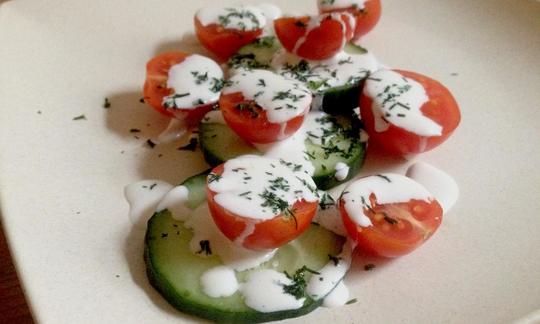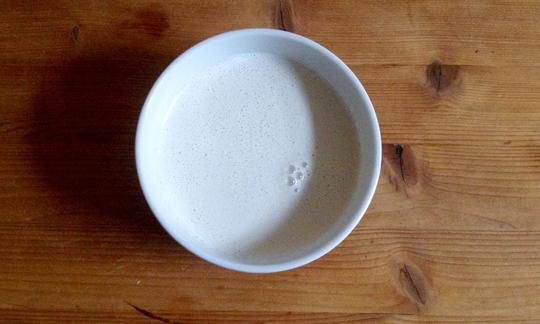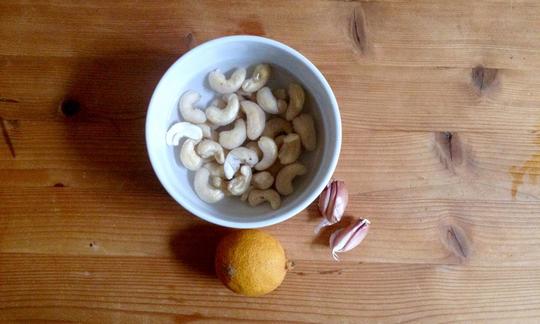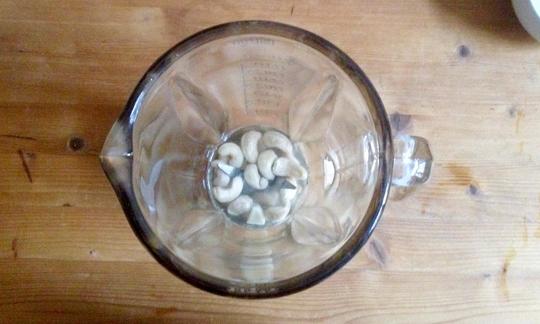Raw vegan garlic sauce with cashews and lemon
raw-vegan
Ingredients (for serving, )
| For the sauce base | |
|---|---|
| 2 ⅛ oz | Cashew nuts, raw? organic? (cashew nuts) |
| 100 ml | Drinking water, raw (organic?) (3.5 oz) |
| 2 cloves | Garlic (organic?) (0.21 oz) |
| To refine the taste | |
| 1 dash | Table salt (table salt, raw?, organic?) (0.01 oz) |
| ¼ tbsp | Lemon juice (raw?, organic?) (0.06 oz) |
Equipment
- blender or hand-held blender / immersion blender
Type of preparation
- food preparation without heating
- soak
- blend
- strain
- season to taste
Preparation
For the sauce base
Soak cashews in water for about 3 hours.In general, cashews are a fairly soft type of nut anyway, so you can skip or shorten the soaking process if necessary. Apart from nutritional benefits, soaking also ensures that the cashews have a better consistency for further processing.
Pour off the soaking water and rinse the cashews in a sieve with clean water.
Peel the garlic cloves and place them in a blender along with the cashews and water.
To refine the taste
Mix the ingredients in a blender until you have a fine cream and season with a little salt.Transfer the cream to a bowl, add lemon juice, mix well and season to taste one last time.
If you don't need the sauce right away, we recommend storing it in a cool place.
The raw vegan garlic sauce will keep in the refrigerator for about 3 days if kept well sealed.
|
Nutritional Information per person
Convert per 100g
|
2000 kcal | |
|---|---|---|
| Energy | 341 kcal | 17.1% |
| Fat/Lipids | 26 g | 37.6% |
| Saturated Fats | 4.7 g | 23.4% |
| Carbohydrates (inc.dietary fiber) | 20 g | 7.5% |
| Sugars | 3.7 g | 4.1% |
| Fiber | 2.1 g | 8.4% |
| Protein/Albumin | 11 g | 22.6% |
| Cooking Salt (Na:167.3 mg) | 425 mg | 17.7% |
| Essential micronutrients with the highest proportions | per person | 2000 kcal | |
|---|---|---|---|
| Min | Copper, Cu | 1.3 mg | 135.0% |
| Prot | Tryptophan (Trp, W) | 0.18 g | 71.0% |
| Min | Manganese, Mn | 1.1 mg | 55.0% |
| Elem | Phosphorus, P | 365 mg | 52.0% |
| Elem | Magnesium, Mg | 178 mg | 47.0% |
| Fat | Linoleic acid; LA; 18:2 omega-6 | 4.7 g | 47.0% |
| Prot | Threonine (Thr, T) | 0.42 g | 45.0% |
| Prot | Valine (Val, V) | 0.67 g | 42.0% |
| Prot | Isoleucine (Ile, I) | 0.49 g | 39.0% |
| Prot | Phenylalanine (Phe, F) | 0.58 g | 38.0% |
Detailed Nutritional Information per Person for this Recipe
The majority of the nutritional information comes from the USDA (US Department of Agriculture). This means that the information for natural products is often incomplete or only given within broader categories, whereas in most cases products made from these have more complete information displayed.
If we take flaxseed, for example, the important essential amino acid ALA (omega-3) is only included in an overarching category whereas for flaxseed oil ALA is listed specifically. In time, we will be able to change this, but it will require a lot of work. An “i” appears behind ingredients that have been adjusted and an explanation appears when you hover over this symbol.
For Erb Muesli, the original calculations resulted in 48 % of the daily requirement of ALA — but with the correction, we see that the muesli actually covers >100 % of the necessary recommendation for the omega-3 fatty acid ALA. Our goal is to eventually be able to compare the nutritional value of our recipes with those that are used in conventional western lifestyles.
| Essential fatty acids | per person | 2000 kcal |
|---|---|---|
| Linoleic acid; LA; 18:2 omega-6 | 4.7 g | 47.0% |
| Alpha-Linolenic acid; ALA; 18:3 omega-3 | 0.04 g | 2.0% |
| Essential amino acids | per person | 2000 kcal |
|---|---|---|
| Tryptophan (Trp, W) | 0.18 g | 71.0% |
| Threonine (Thr, T) | 0.42 g | 45.0% |
| Valine (Val, V) | 0.67 g | 42.0% |
| Isoleucine (Ile, I) | 0.49 g | 39.0% |
| Phenylalanine (Phe, F) | 0.58 g | 38.0% |
| Leucine (Leu, L) | 0.90 g | 37.0% |
| Lysine (Lys, K) | 0.57 g | 31.0% |
| Methionine (Met, M) | 0.22 g | 24.0% |
| Vitamins | per person | 2000 kcal |
|---|---|---|
| Vitamin K | 21 µg | 27.0% |
| Thiamine (vitamin B1) | 0.27 mg | 24.0% |
| Vitamin B6 (pyridoxine) | 0.32 mg | 23.0% |
| Biotin (ex vitamin B7, H) | 6.9 µg | 14.0% |
| Pantothenic acid (vitamin B5) | 0.56 mg | 9.0% |
| Folate, as the active form of folic acid (née vitamin B9 and | 16 µg | 8.0% |
| Vitamin E, as a-TEs | 0.55 mg | 5.0% |
| Vitamin C (ascorbic acid) | 2.9 mg | 4.0% |
| Niacin (née vitamin B3) | 0.68 mg | 4.0% |
| Riboflavin (vitamin B2) | 0.04 mg | 3.0% |
| Essential macroelements (macronutrients) | per person | 2000 kcal |
|---|---|---|
| Phosphorus, P | 365 mg | 52.0% |
| Magnesium, Mg | 178 mg | 47.0% |
| Potassium, K | 422 mg | 21.0% |
| Sodium, Na | 167 mg | 21.0% |
| Calcium, Ca | 36 mg | 5.0% |
| Essential trace elements (micronutrients) | per person | 2000 kcal |
|---|---|---|
| Copper, Cu | 1.3 mg | 135.0% |
| Manganese, Mn | 1.1 mg | 55.0% |
| Zinc, Zn | 3.5 mg | 35.0% |
| Iron, Fe | 4.1 mg | 29.0% |
| Selenium, Se | 13 µg | 23.0% |
| Fluorine, F | 74 µg | 2.0% |
| Iod, I (Jod, J) | 3.2 µg | 2.0% |
This raw vegan garlic sauce made from cashews, lemon and garlic can be varied and used in many different ways!
Using the garlic sauce: This sauce is suitable for use wherever you need to make yogurt sauce in vegetarian recipes, such as wraps or tomato rice. It can also be used as a salad dressing or to refine other raw food creations.
It is also delicious as a pasta sauce (for dough noodles as well as for zucchini noodles) or on steamed cauliflower.
Peeling garlic: To speed up the peeling process and reduce the smell of garlic on your hands, there is a simple method:
Point the tip of the clove at the work surface and apply pressure to the toe with your hand or an object so that the peel cracks. Now put the cloves in a sealable container, such as a preserving jar, and shake it vigorously after closing it. After opening, the cloves should fall out completely peeled.
This trick is especially useful when processing large quantities of garlic; it is also possible to separate a whole bulb from the skin by shaking it.
Dipping sauce: If the sauce is intended to be used more as a dipping sauce, use less water.
Tsatsiki: With a little less water and grated cucumber stirred in, you can make a vegan tzatziki.
Herbs: You can also vary the sauce with any herbs you want - depending on what you want to serve it with. Chives, parsley or even wild garlic go well with it.










